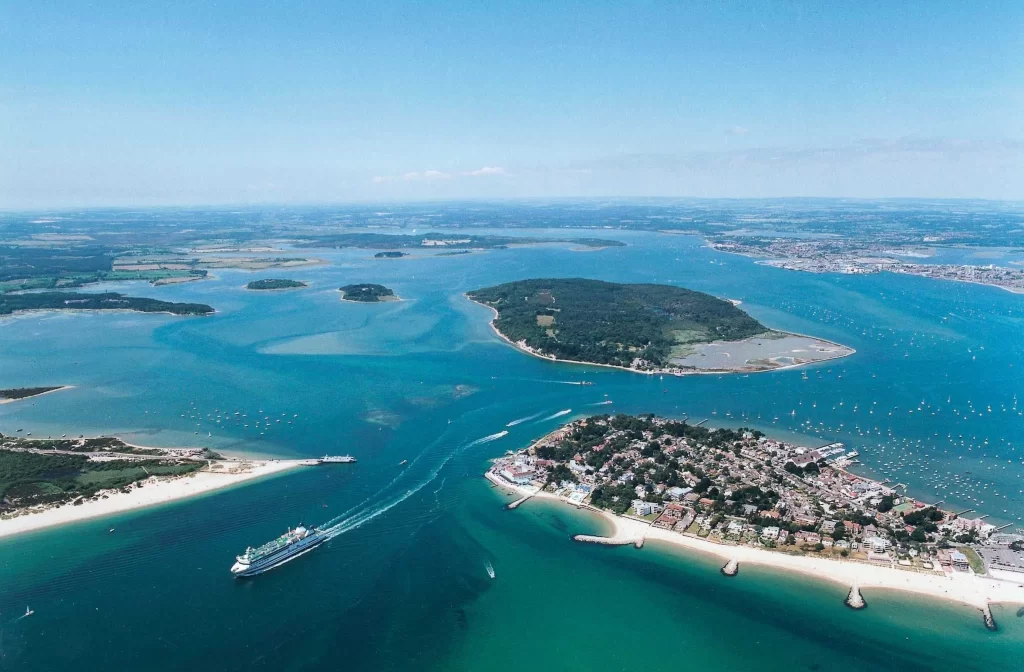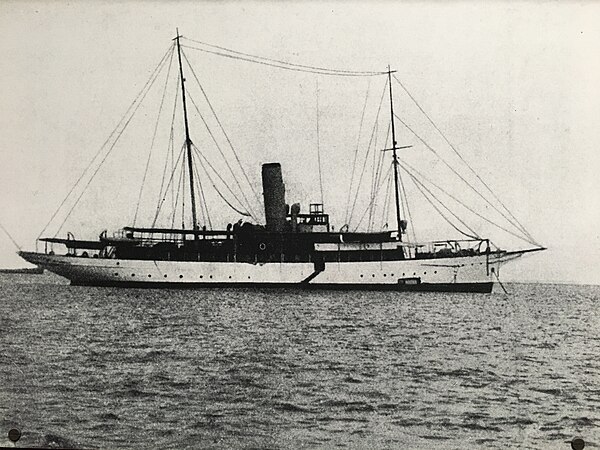Tubarão (P)
shark (E)
requin (F)
squalo (I)
tiburón (S)
poole Harbor, england

Poole Harbor is the largest natural harbor in Europe and the second largest natural harbor in the world after Sydney Harbor in Australia. It sits on the southern coast of England, west of Portsmouth, the Isle of Wight and the Solent. Looking at the picture above, the ship (likely a Brittany ferry on its way to Cherbourg, France) is heading out into the English Channel or La Manche as the French call it. Poole is home to the headquarters of the Royal National Lifeboat Institution, a charity that provides lifesaving and safety services around Great Britain and, for those lottery winners or those who dream among you, is also where Sunseeker Yachts are built. Are there any sharks in the waters around Poole harbor or out in the English Channel? Yes, likely around 40 different species. Any great white sharks? Not likely.
Poole was where Guglielmo Marconi conducted experiments trying to perfect his radio-wave based wireless telegraph system. Who???? Guglielmo Marconi, an Italian born in 1874, who spent most of his life developing a wireless telegraph system. At the beginning of the 20th century, people could already communicate via wires (think telephones and telegraphs) but no wires meant no communications. It’s hard to imagine now, where every person with a cellular phone can communicate with almost everyone almost everywhere, but in the early 1900’s, once ships ventured offshore, they had no way to communicate unless they were within sight of the place or ship with which they wanted to communicate.
Marconi was very intrigued with the possibility of using radio waves, first discovered by Heinrich Hertz, to power a wireless telegraphy system. Long story short, after a number of successful experiments that did not impress the Italian government, Marconi made his way to England in 1896 with his mother, who happened to be the granddaughter of the founder of Jameson whisky. The British government was interested in his experiments. He continued his work and on May 13, 1897, transmitted the first ever wireless message 6 kilometers over open sea across the Bristol Channel. The message read “Are you ready”. More refinements followed and in March 1899, he sent the first message across the English Channel from Wimereaux, France to South Foreland Lighthouse, England.
Discovering that the taller the radio tower, the further transmissions could be heard, Marconi set up a 100-foot-high tower or mast at the Haven Hotel, Sandbanks, Poole Harbor, located on the right-hand side of the harbor when entering from the English Channel. He became friends with the owners of Brownsea Island, the island across from the Haven Hotel, and his steam yacht, the Elettra, which had been converted to a laboratory, was often moored near the island or the hotel.

Marconi also determined that radio transmissions traveled further at night. He saw the commercial potential of his discoveries and built stations at Poldhu, Cornwall and Glace Bay, Nova Scotia, to allow for communication across the Atlantic Ocean between the United States and Great Britain. On December 17, 1902, the first radio message to cross the Atlantic from North America was transmitted from his station at Glace Bay, Nova Scotia. Trying to find the best place to transmit from the United States, in 1901, Marconi built a radio station on the eastern bluffs of Cape Cod, near South Wellfleet, Massachusetts. Yes, that Wellfleet, famous for its oysters.

The towers in South Wellfleet were over 200 feet tall. On January 18, 1903, the first public two-way wireless communication between Europe and America occurred. Communiques from President Theodore Roosevelt and King Edward VII were translated into international Morse code at the South Wellfleet and English stations, respectively, and were broadcast and received. Ocean-going vessels quickly adopted Marconi apparatus to receive news broadcasts and soon ship-to-shore transmittals were a major operation. Business and social messages could be sent for fifty cents a word. The South Wellfleet station became the lead North American facility for this function. However, Marconi’s invention’s greatest contribution was to ship safety as ships could now send out distress signals. The two radio operators on board the RMS Titanic who sent out the distress signals that brought the RMS Carpathia to the rescue in 1912 were employees of the Marconi International Marine Communication company. In 1909, Marconi, along with Robert Braun, won the Nobel Prize for Physics for his contributions to radio-wave technology.
With new developments in technology and security concerns during World War I, the towers in South Wellfleet were closed and eventually fell into the sea. The area is now near Marconi Beach, part of the Cape Cod National Seashore, more well known as an area frequented by great white sharks than as being the Silicon Valley of 1903. (See, we got back to our word of the day.) While there may not be great white sharks off of Poole harbor, there certainly are great white sharks off the site of Marconi’s towers in South Wellfleet. In fact, there is a buoy off of South Wellfleet, transmitting info ashore whenever a tagged great white shark, passes it, which, in the summer months, is surprisingly often. Guglielmo would be happy.